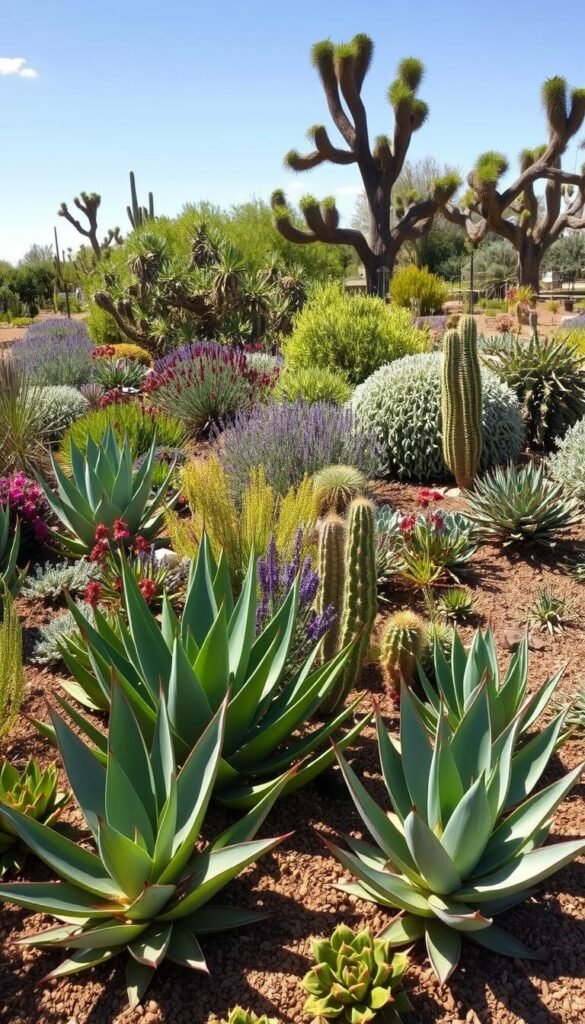Traditional lawns and thirsty flower beds are becoming relics of the past. As climate patterns shift and water costs rise, many homeowners are reimagining their outdoor spaces with resource-smart strategies that balance beauty and practicality. This approach isn’t just about survival—it’s about creating a vibrant, low-maintenance retreat that thrives even in dry conditions.
By focusing on native species and climate-adapted varieties, you can design a lively landscape that sips water instead of guzzling it. Pairing these choices with efficient irrigation methods—like drip systems or principles of permaculture—ensures every drop counts. Even small changes, such as adding mulch or grouping plants by water needs, make a measurable difference.
Urban dwellers aren’t left out: compact solutions like container gardens prove you don’t need vast yards to practice sustainability. Lightweight pots with self-watering features or fabric grow bags help manage moisture for herbs, shrubs, and ornamental grasses.
This shift toward mindful outdoor design doesn’t just lower bills—it builds resilient ecosystems that support local wildlife. Whether you’re revamping a suburban backyard or a patio oasis, these methods adapt to your region’s unique challenges while keeping your space lush and inviting.
Understanding the Basics of Eco Garden Landscaping
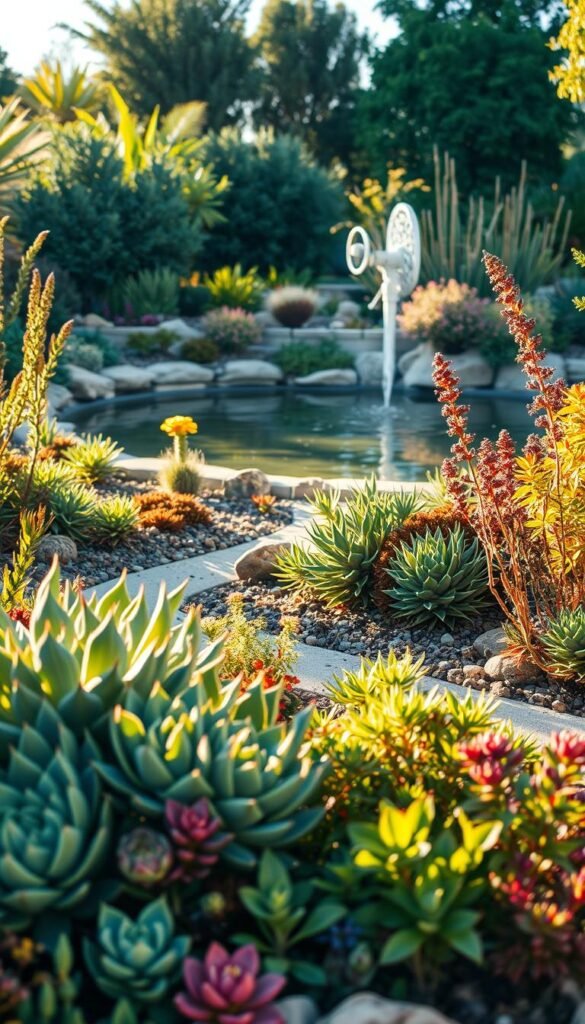
Imagine transforming your yard into a thriving space that works with your local environment. This approach centers on balancing beauty with practicality, using smart strategies that adapt to your region’s unique conditions.
What Does Sustainable Yard Design Mean?
It’s about creating outdoor areas that need minimal watering and upkeep. By choosing native species and grouping plants by their needs, you build a resilient space. Innovative approaches like permeable paving and rain gardens help manage moisture naturally.
Why Choose a Low-Water Approach?
Beyond saving money on bills, this method supports bees, butterflies, and local birds. Studies show these spaces use 50-70% less water than traditional lawns. You’ll also spend less time watering and more time enjoying your retreat.
| Traditional Gardening | Water-Wise Approach | Key Difference |
|---|---|---|
| Daily watering needed | Weekly irrigation | 70% less water use |
| Frequent fertilizer use | Natural soil health | Lower maintenance |
| Limited wildlife value | Supports pollinators | Ecosystem benefits |
Simple changes make big impacts. Adding mulch keeps roots moist, while smart irrigation solutions deliver water directly to plants. Over time, these choices create a lush space that thrives in dry spells.
Water-Saving Techniques and Efficient Irrigation Methods
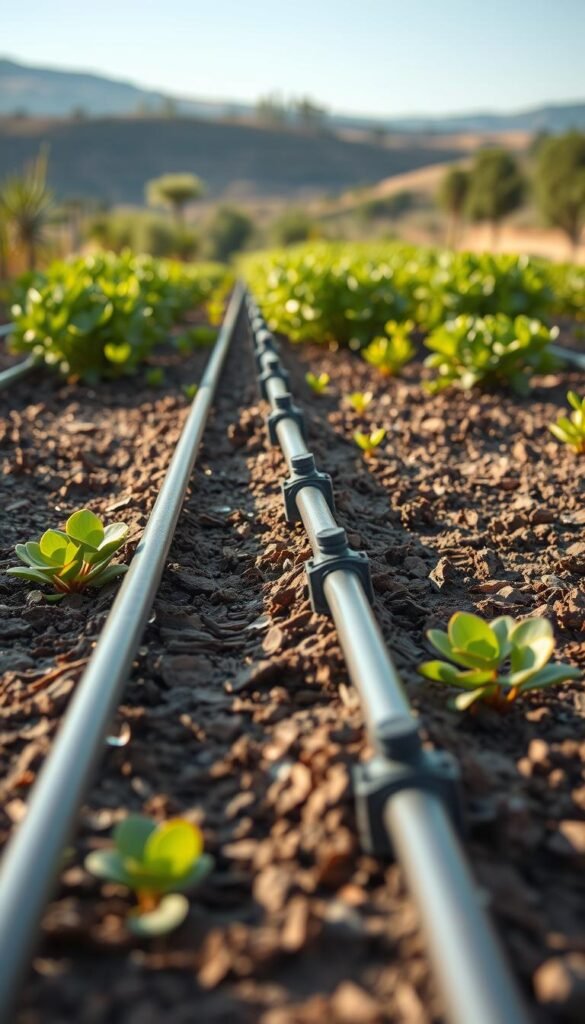
What if every drop of water in your yard worked smarter, not harder? Modern solutions let you maintain lush greenery while cutting waste dramatically. The secret lies in precision delivery and timing that syncs with nature’s rhythms.
Precision Water Delivery Made Simple
Drip irrigation systems are game-changers, sending moisture straight to roots through tiny emitters. Unlike sprinklers that spray leaves and air, these setups deliver water directly where plants need it most. Pair them with drip irrigation kits for easy installation in raised beds or containers.
Smart controllers take it further. They adjust flow based on real-time weather data and soil sensors. No more guessing—your system waters only when necessary, preventing soggy soil or parched plants.
Working With the Sun’s Schedule
Timing matters as much as technique. Water between 5-7 AM or after 6 PM when cooler temps slow evaporation. This simple shift lets soil absorb up to 90% of moisture instead of losing it to midday heat.
Group plants by thirst levels to streamline your irrigation zones. Pair this with soaker hoses for areas where full drip setups aren’t practical. You’ll cut water use by half compared to traditional methods.
Eco Garden Landscaping: Drought-Tolerant Plants and Water-Saving Techniques
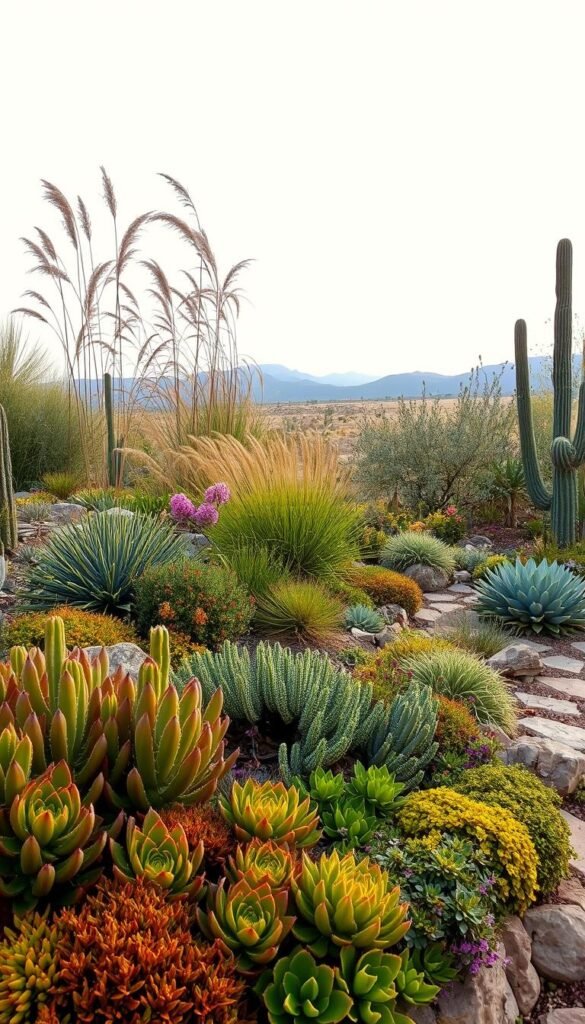
Creating a resilient outdoor space starts with smart plant choices and resource management. Pairing species that thrive in dry conditions with simple moisture-saving methods transforms your yard into a low-effort sanctuary.
Choosing the Right Drought-Tolerant Plants
Your selection should focus on varieties that laugh at dry spells. Lavender brings fragrant blooms and buzzing pollinators, while sedum stores water in its fleshy leaves. For structure, try Russian sage’s silvery stems or barberry’s vibrant foliage.
| Plant Type | Top Picks | Water Needs |
|---|---|---|
| Succulents | Aloe Vera, Agave | Every 3-4 weeks |
| Ornamental Grasses | Blue Oat Grass | Natural rainfall |
| Groundcovers | Creeping Thyme | Minimal irrigation |
Integrating Rainwater Harvesting and Mulching
Capture free water by directing roof runoff into barrels through gutters. This stored resource keeps plants hydrated during summer droughts. Spread 2-3 inches of mulch around beds to lock in moisture and block weeds.
Groundcovers like ice plant form colorful mats that eliminate thirsty lawns. For low-maintenance options, combine self-sufficient cacti with native perennials already adapted to local conditions. These partnerships create visual interest while slashing water use.
Improving Soil Health and Mulching Practices for Better Moisture Retention
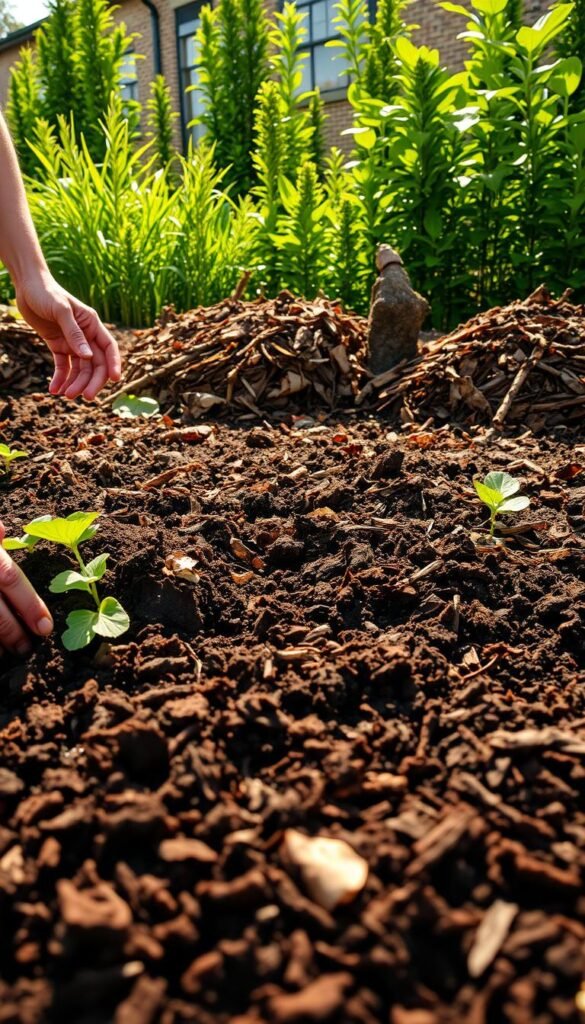
Healthy soil acts like a living reservoir, storing water and nutrients for plants. By focusing on its structure and protection, you create a foundation where roots thrive even during dry spells. Let’s explore how simple adjustments can turn your ground into a moisture-retaining powerhouse.
Boosting Soil Structure With Compost
Mixing compost into your earth is like giving it a vitamin boost. This organic matter creates air pockets, letting water seep deeper instead of pooling. A single cup of compost can hold nearly five cups of moisture—perfect for thirsty roots during summer.
Mulch: Your Garden’s Protective Blanket
Spread 3 inches of bark chips or straw around plants to lock in hydration. This layer slows evaporation by up to 70% compared to bare dirt. Bonus: it blocks weeds that steal water from your greens.
| Mulch Type | Best For | Moisture Retention |
|---|---|---|
| Wood Chips | Shrubs/Trees | High |
| Straw | Vegetables | Medium-High |
| Gravel | Succulents | Low |
Crafting the Ideal Growing Environment
Before planting, loosen compacted areas and mix in compost. This prep work helps roots grow deeper, accessing hidden water reserves. Pair this with no-till methods to maintain your soil’s spongy texture season after season.
Remember: healthy earth means less watering. As organic mulches break down, they feed microbes that strengthen plants naturally. Your garden becomes self-sufficient—saving you time and resources.
Final Inspirations for Your Eco-Friendly Outdoor Oasis
Your journey to a smarter outdoor space begins with understanding your yard’s personality. Map sunlight patterns and soil drainage to craft a landscape master plan that works with nature, not against it. Start small—swap a patch of thirsty grass for textured gravel paths or a rock garden filled with low-maintenance blooms that laugh at dry spells.
Sloped areas become allies when shaped into terraced beds or rain gardens. These features catch stormwater, letting it seep slowly into the earth instead of racing down driveways. Pair permeable pavers with strategic plant groupings—cluster moisture-loving greens in one zone and sun-hardy varieties in another.
Your yard’s new rhythm will surprise you. Weekly watering shifts to occasional check-ins as resource-smart outdoor spaces establish their roots. Over time, you’ll spend less on upkeep and more evenings enjoying your thriving retreat—proof that thoughtful design creates beauty that endures.

